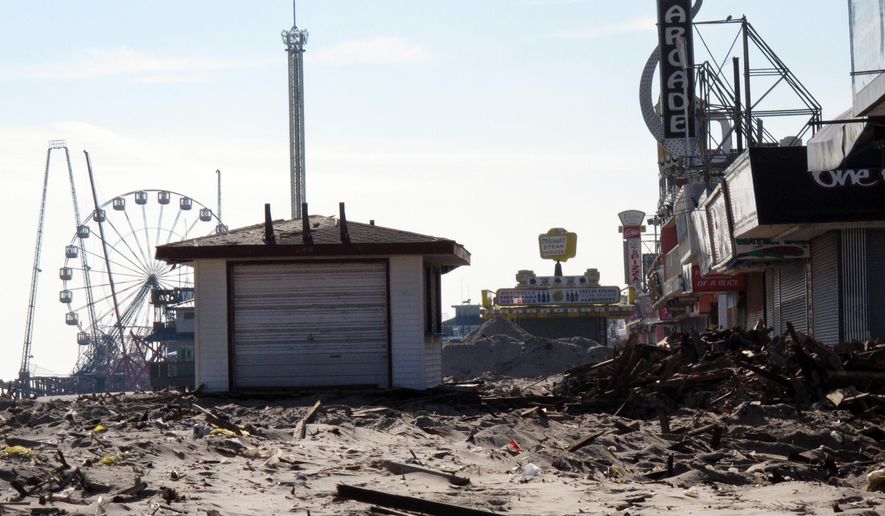Many victims of the last massive storm to swamp the U.S., 2012’s Superstorm Sandy, are still waiting for their government checks — raising questions about Federal Emergency Management Agency’s ability to dole out financial relief in the oncoming Harvey-Irma onslaught.
“I received my check the second week of August so that is the process that will happen to everyone in Houston and everyone in Florida. It was a five-year wait for us to receive our money,” said Claudette D’Arrigo from Highlands, New Jersey, whose home had seven feet of standing water after Sandy.
Her check came from FEMA’s flood insurance program, which is a national backstop to provide coverage in areas where the private industry is wary of offering policies, saying the risks are too great.
The already-burdened flood program is about to face a slew of new claims in the wake of Hurricane Harvey, which slammed southeastern Texas last month, and Hurricane Irma, which blasted Florida this week.
“FEMA is not effectively handling Sandy from five years before — to think how they’re going to effectively handle victims from Harvey and Irma is mind boggling,” said Augie Matteis, managing partner of Weisbrod Matteis & Copley, which handles disaster relief claims.
He had 1,200 clients from Sandy, and he said 900 of them are still waiting for checks. Most of his clients initially received low settlement offers in 2012 and 2013, but then FEMA reopened Sandy claims in 2015 after accusations of fraud and underpayments. All of Mr. Matteis’ clients reopened their claims.
He said some had originally been offered nothing, while the average payout was around $12,000 per claim.
“All of our clients rejected those low-balls and we brought all their claims to third party neutral arbitrators,” he said. “We are averaging over 40K per claim for our clients who have toughed it out and gone all the way to these hearings.”
Pat Ryan, who worked for New York City’s Sandy recovery program before working for Rep. Dan Donovan, New York Republican, said the underpayment for flood damage and the reopening of the claims process for Sandy was a major issue for FEMA that is unlikely to happen with Harvey and Irma.
As of Sept. 8, FEMA says it has closed 16,900 Sandy claims that had been reopened for review in 2015 out of roughly 19,400, and it has made a number of changes to improve its service and operations.
“It’s my understanding that the majority of those have been settled and moved on,” said Mr. Ryan.
A spokeswoman from FEMA told The Washington Times they have made improvements over the past few years, and created the Office of the Flood Insurance Advocate, which is an independent office advocating for policyholders and property owners.
FEMA has also established a toll-free line for policyholders to call if they are frustrated or confused with their agent or insurance company.
“We have enhanced our quality control processes over our adjusters and the back offices. We’ve made the appeals process fairer, we’ve changed our oversight litigation and have developed this transparent relationship with state insurance commissioners,” Roy Wright, director of the National Flood Insurance Program, said on Sept. 13.
Earlier this month, the National Flood Insurance Program also told private insurance partners to provide advance payments to rush recovery money for Texas and Louisiana victims of Harvey.
The initial underpayments following Sandy may have been a result of the debt FEMA’s flood program inquired in the aftermath of Hurricane Katrina in 2005 after private insurers made fraudulent claims to escape paying out of their own pockets, Mr. Matteis speculated.
Last year, the Supreme Court upheld a verdict finding State Farm Fire and Casualty Co. defrauded the federal government in the aftermath of Katrina by mischaracterizing wind damage as flood damage. Flood claims are paid by the government instead of by the private insurers.
A Government Accountability Office report released earlier this year revealed FEMA’s flood program owed the U.S. Treasury $23 billion as of March 2016.
“They don’t have enough money to deal with Harvey, to deal with Irma,” Mr. Matteis said.
It’s set to expire on Dec. 8 unless Congress reauthorizes it. A number of bills proposing reforms have been offered in both the House and the Senate.
The agency had at least 140,000 flood claims following Sandy and it is facing more than 85,000 flood claims after Harvey. FEMA doesn’t have a current estimate for Irma claims.
• Alex Swoyer can be reached at aswoyer@washingtontimes.com.




Please read our comment policy before commenting.